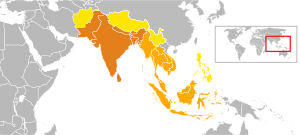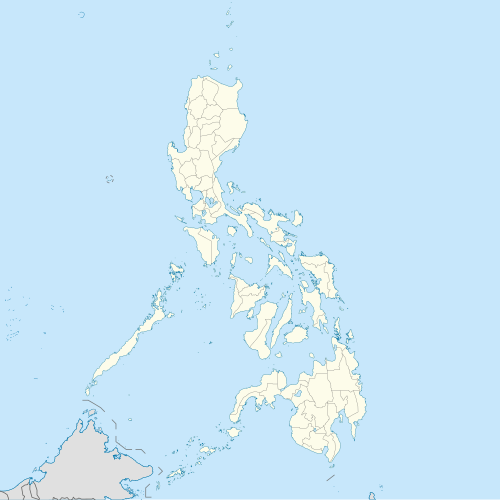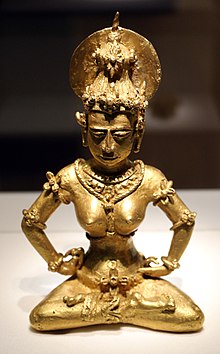List of India-related topics in the Philippines
Bilateral relations
 | |
 India |  Philippines |
|---|---|
| Diplomatic mission | |
| Embassy of India[1] 2190 Paraiso, Makati, Metro Manila, Philippines Phone:+63 922 340 4676 Google map | Embassy of Philippines[2] 50-N Nyaya Marg, Chanakyapuri, New Delhi 110021, India Phone: +91 11 2611 0152 Google map |
| Envoy | |
| Ambassador Mr. Lalduhthlana Ralte | Ambassador Ms. Teresita C. Daza |
India and the Philippines have historic ties going back over 3000 years and there are over 150,000 people of Indian origin in Philippines.[3]
Iron Age finds in the Philippines also point to the existence of trade between Tamil Nadu in South India and the Philippine islands during the ninth and tenth centuries B.C.[4] The influence of the culture of India on the culture of the Philippines intensified from the 2nd through the late 14th centuries CE.[5]
The Indian-Filipinos are Philippine citizens of Indian descent. The NRI are Indian citizens living in Philippines.
This is an alphabetical list:
History



Tondo

Cainta
class=notpageimage|
Locations of pre-colonial principalities, polities, kingdoms and sultanates in the Philippine archipelago

Indianisation concepts
- Indianisation
- Greater India
- Mandala (political model)
- Indosphere
- Sanskritisation
- One of the pre-Spanish pre-Catholic pre-colonial ancient native Names of the Philippines is Maharlika "freeman" from ancient Indian language Sanskrit. And they are proposals to rename the Philippines to this name to remove the colonialism.[7][8][9]
- Sanskritisation
- Greater India
- Early industries in Philippines that were introduced from India include boatbuilding, metal works, weaving of cotton clothes and quicklime mining method.
- Flowers and their Sanskrit names introduced to Philippines by the Indian traders during the ancient times include sampaguita the National flower of Philippines which is one of National symbols of the Philippines and champaka.[10][11]
- Fruits and their Sanskrit names introduced to Philippines by the Indian traders during the ancient times include mango, nangka (Jackfruit) and sirisa.
Indianised kingdoms of early Philippines history
- Maritime Southeast Asia
- History of Indian influence on Southeast Asia
- Indian influences in early Philippine polities
- Indianised kingdoms of Philippines
- Super kingdoms spanning several present day nations
- Srivijaya empire: a Hindu-Buddhist kingdom also included Luzon and Visayas, rival of Mataram who also ruled Mindanao
- Kingdom of Mataram: a Hindu kingdom rival of Buddhist Srivijara, its king was Balitung mentioned in the Balitung inscription, spread across Java in southern Indonesia and Sulu/Mindanao in southern Philippines
- Luzon
- Around Manila and Pasig river were 3 polities which were earlier Hindu-Buddhist, later Islamic and then subsumed and converted to Catholicism by Spanish in 16th century
- Namayan polity was confederation of barangays
- Maynila (historical entity)
- Rajah Sulayman (also Sulayman III, 1558–1575), Indianized Kingdom of Maynila
- Rajah Matanda (1480–1572), ruler of the Indianized Kingdom of Maynila, together with Rajah Sulayman was co-ruled Maynila, their cousin Lakan Dula ruled Tondo. Rajah Sulayman was one of three kings that ruled parts of present-day Manila, and fought against the Spanish Empire's colonisation of the Philippines
- Tondo (Historical State) on Pasig river near Manila
- Lakan Dula, was a raja who was cousin of Rajah Sulayman and Rajah Matanda
- Laguna Copperplate Inscription, earliest known written document found in the Philippines, in Indianized Kawi script with Sanskrit loanwords
- Ma-i Buddhist kingdom of Mindoro island, from before 10th century till 14th century
- 1406–1576 Caboloan,[12] was a sovereign pre-colonial Philippine polity located in the fertile Agno River basin and delta, with Binalatongan as the capital.[13] The polity of Pangasinan sent emissaries to China in 1406–1411.[14]
- Around Manila and Pasig river were 3 polities which were earlier Hindu-Buddhist, later Islamic and then subsumed and converted to Catholicism by Spanish in 16th century
- Visayas
- Rajahnate of Cebu at Singhapala (Mabolo in Cebu city on Mahinga creek) capital city in southern Cebu island was Hindu-kingdom founded by Sri Lumay or Rajamuda Lumaya, a minor prince of the Chola dynasty of India which occupied Sumatra. He was sent by the Maharajah from India to establish a base for expeditionary forces, but he rebelled and established his own independent rajahnate.[15] Subsumed by Spanish in 16th century.
- King Sri Lumay was half Tamil and half Malay, noted for his strict policies in defending against Moro Muslim raiders and slavers from Mindanao. His use of scorched earth tactics to repel invaders gave rise to the name Kang Sri Lumayng Sugbu (literally "that of Sri Lumay's great fire") to the town, which was later shortened to Sugbu ("scorched earth").
- Sri Bantug, king and successor son of Sri Lumay
- Rajah Humabon, king and successor son of Sri Batung
- Battle of Mactan on 27 April 1521 between Rajah Humabon and Ferdinand Magellan in which Lapulapu fought on side of Rajah, resulting in the death of Ferdinand Magellan.
- Lapulapu, warrior under Rajah Humabon, Lapulapu fought Spanish
- Ferdinand Magellan, Portuguese explorer on hired by Spanish empire
- Rajah Tupas (Sri Tupas), nephew and successor of Rajah Humabon, last to rule the kingdom before subsumed by Spanish Miguel López de Legazpi in the battle of Cebu during 1565.
- Caste system: Below the rulers were the Timawa, the feudal warrior class of the ancient Visayan societies of the Philippines who were regarded as higher than the uripon (commoners, serfs, and slaves) but below the Tumao (royal nobility) in the Visayan social hierarchy. They were roughly similar to the Tagalog maharlika caste. Lapu Lapu was a Timawa.
- A crude Buddhist medallion and a copper statue of a Hindu Deity, Ganesha, has been found by Henry Otley Beyer in 1921 in ancient sites in Puerto Princesa, Palawan and in Mactan, Cebu.[16] The crudeness of the artifacts indicates they are of local reproduction. Unfortunately, these icons were destroyed during World War II. However, black and white photographs of these icons survive.
- Kedatuan of Madja-as of Panay island was a supra-baranganic polity from 14th century till 16th century until subsumed by Spanish, were migrants from North Sumatra in Indonesia where they were rulers of Buddhist Srivihayan "kingdom of Pannai" (ruled 10 to 14th century) which was defeated by Majapahit.
- Rajahnate of Cebu at Singhapala (Mabolo in Cebu city on Mahinga creek) capital city in southern Cebu island was Hindu-kingdom founded by Sri Lumay or Rajamuda Lumaya, a minor prince of the Chola dynasty of India which occupied Sumatra. He was sent by the Maharajah from India to establish a base for expeditionary forces, but he rebelled and established his own independent rajahnate.[15] Subsumed by Spanish in 16th century.
- Mindanao
- Kingdom of Butuan in northeast Mindanao, Hindu kingdom existed earlier than 10th century and ruled till being subsumed by Spanish in 16th century
- Golden Tara (Agusan image) is a golden statue that was found in Agusan del Sur in north east Mindanao.
- Mount Diwata: named after diwata concept of Philippines based on the devata deity concept of Hinduism
- Sultanate of Lanao of Muslims in Maguindanao in northwestern Mindanao from 15th century till present day
- Sultanate of Maguindanao in Cotabato in far west Mindanao from split from Srivijaya Hindu ancestors in 16th century and ruled till early 20th century, originally converted by sultan of Johor in 16th century but maintained informal kinship with Hindu siblings who are now likely Christians
- Sultanate of Sulu in southwestern Mindanao, established in 1405 by a Johore-born Muslim explorer, gained independence from the Bruneian Empire in 1578 and lasted till 1986. It also covered the area in northeastern side of Borneo, stretching from Marudu Bay to Tepian Durian in present-day Kalimantan.
- Lupah Su sultanate, predecessor Islamic state before the establishment of Sultanate of Sulu.[17]
- Maimbung principality: Hindu polity, predecessor of Lupah Su]] Muslim sultanate. Sulu that time was called Lupah Sug[17] The Principality of Maimbung, populated by Buranun people (or Budanon, literally means "mountain-dwellers"), was first ruled by a certain rajah who assumed the title Rajah Sipad the Older. According to Majul, the origins of the title rajah sipad originated from the Hindu sri pada, which symbolises authority.[18] The Principality was instituted and governed using the system of rajahs. Sipad the Older was succeeded by Sipad the Younger.
- Kingdom of Butuan in northeast Mindanao, Hindu kingdom existed earlier than 10th century and ruled till being subsumed by Spanish in 16th century
Indians in Philippines during colonial era
- 1762–1764 British Manila
- Battle of Manila (1762) by the East India Company's Indian soldiers during Anglo-Spanish War (1761–63)
- Cainta in Rizal: historic colonial era settlement of escaped Indians sepoys of British East India Company
- Indian Filipino: Filipino citizens with part or whole Indian blood
Key Indianised Hindu-Buddhist artifacts found in Philippines
- Luzon
- Laguna Copperplate Inscription in Luzon, earliest known written document found in the Philippines, in Indianized Kawi script with Sanskrit loanwords
- Palawan Tabon Caves Garuda Gold Pendant found in the Tabon caves in the island of Palawan, is an image of Garuda, the eagle bird who is the mount of Hindu deity Vishnu[19]
- Visayas
- Rajahnate of Cebu Buddhist medallion and copper statue of Hindu Deity: A crude Buddhist medallion and a copper statue of a Hindu Deity, Ganesha, has been found by Henry Otley Beyer in 1921 in ancient sites in Puerto Princesa, Palawan and in Mactan, Cebu.[16] The crudeness of the artifacts indicates they are of local reproduction. Unfortunately, these icons were destroyed during World War II. However, black and white photographs of these icons survive.
- Mindanao
- Golden Tara (Agusan image) from Kingdom of Butuan in northeast Mindanao is a golden statue that was found in Agusan del Sur in north east Mindanao.
Language
- Baybayin: a Philippine script classified as an abugida, part of the Brahmic family of scripts
- Indian honorifics also influenced the Malay, Thai, Filipino and Indonesian honorifics.[20] Examples of these include Raja, Rani, Maharlika, Datu, etc. which were transmitted from Indian culture to Philippines via Malays and Srivijaya empire
- Influence of Indian languages on Tagalog language
- Sanskrit language loanwords in Cebuano language
Sports
Filipino sports influenced by the Indian martial arts
- Filipino martial arts such as Kalis and others have been inspired by the Indian martial arts
Art, music, epics and chants
- Filipino epics and chants inspired by the Indian Hindu religious epics Ramayana and Mahabharata.
- Alim and Hudhud Oral traditions of Ifugao of Ifugao people of the Cordillera Administrative Region in Luzon island. The Hudhud – the Ifugao epic of the Ifugao was chosen as one of the 11 Masterpieces of the Oral and Intangible Heritage of Humanity in 2001 and formally inscribed as a UNESCO Intangible Cultural Heritage in 2008.
- Biag ni Lam-ang (English: "The Life of Lam-ang") is an epic poem of the Ilocano people from the Ilocos region.
- Ibalong epic of Bikol region of southeast Luzon.
- "Aginid, Bayok sa atong Tawarik", a Bisayan epic of Cebu.
- Bayok, an epic of Marano people of northwestern Mindanao.
- Music instrument
- Kudyapi, native Filipino guitar of Maranao, Manobo and Maguindanao people, is influenced by the Indian classical music concepts of melody and scale.
Religion
- Buddhism in Southeast Asia
- Hinduism in Southeast Asia
- Related topics
- Religion in pre-colonial Philippines had Indianized Hindu and Buddhist influence
- Nanak Darbar Indian Sikh Temple, Iloilo
People
- List of Filipino-Indian people
- Josephine Acosta Pasricha, PhD (Indology) – Filipina Indologist
- Juan R. Francisco, PhD (Indology) – Filipino Indologist
- Filipinos in India
Business
- Business process outsourcing to India
- Business process outsourcing in the Philippines
- Indian Companies, some operate in Philippines also
- Murrah buffalo originally from the Central Institute for Research on Buffaloes, Hisar, Haryana, India was exported to Philippine Carabao Center in Nueva Ecija to improve the breed of Filipino carabao
- Maritime Southeast Asia under the influence of Indosphere
Politics and travel
- India–Philippines relations
- Visa requirements for Indian citizens
- Visa requirements for Filipino citizens
- Tourism in the Philippines
- Tourism in India
Gallery
-

- Murrah buffalo originally from Punjab and Haryana states of India was exported to Philippine Carabao Center in Nueva Ecija to improve the breed of Filipino carabao
-

-

-
 Pepe Diokno movie director and producer
Pepe Diokno movie director and producer -
 Juan Cailles independence revolutionary
Juan Cailles independence revolutionary
See also
References
- ^ Embassy of India
- ^ Embassy of Philippines
- ^ Indians in Philippines
- ^ Tamil language, www.tamilculturewaterloo.org Archived 13 April 2015 at the Wayback Machine
- ^ The cultural influence of India, www.philippinealmanac.com Archived 1 July 2012 at the Wayback Machine
- ^ Kulke, Hermann (2004). A history of India. Rothermund, Dietmar, 1933– (4th ed.). New York: Routledge. ISBN 0203391268. OCLC 57054139.
- ^ "Historian says 'Maharlika' as nobility a misconception". philstar.com.
- ^ Tan, Samuel K. (2008). A History of the Philippines. UP Press. p. 40. ISBN 978-971-542-568-1.
- ^ "Maharlika means noble? Not so, says historian". ABS-CBN News. 12 February 2019.
- ^ William Henry Scott, 1984, Prehispanic Source Materials for the Study of Philippine History, accessed 1 July 2021.
- ^ Jean-Paul G. POTET, 2013, Arabian and Persian loanwords in Tagalog, p. 250.
- ^ Flores, Marot Nelmida-. The cattle caravans of ancient Caboloan : interior plains of Pangasinan : connecting history, culture, and commerce by cartwheel. National Historical Institute. Ermita: c2007. http://www.kunstkamera.ru/files/lib/978-5-88431-174-9/978-5-88431-174-9_20.pdf
- ^ "Single Post".
- ^ Scott, William Henry (1989). "Filipinos in China in 1500" (PDF). China Studies Program. De la Salle University. p. 8.
- ^ Jovito Abellana, Aginid, Bayok sa Atong Tawarik, 1952
- ^ a b http://www.asj.upd.edu.ph/mediabox/archive/ASJ-15-1977/francisco-indian-prespanish-philippines.pdf [bare URL PDF]
- ^ a b Julkarnain, Datu Albi Ahmad (30 April 2008). "Genealogy of Sultan Sharif Ul-Hashim of Sulu Sultanate". Zambo Times. Archived from the original on 18 July 2011. Retrieved 21 December 2010.
- ^ Ibrahim 1985, p. 51
- ^ Palawan Tabon garuda
- ^ Krishna Chandra Sagar, 2002, An Era of Peace, Page 52.
Works cited
- Ibrahim, Ahmad; Siddique, Sharon; Hussain, Yasmin (1985). Readings on Islam in Southeast Asia. Institute of Southeast Asian Studies. ISBN 978-9971-988-08-1.
- v
- t
- e
- Indianized kingdom in Philippines and Indian cultural influences in early Philippine polities
- Srivijaya
- Majapahit
- Kedatuan of Madja-as
- Kingdom of Butuan
- Maynila (historical entity)
- Kingdom of Namayan
- Rajahnate of Cebu (Rajah Humabon at Singhapala city)
- Rajah Matanda
- Rajah Sulayman
- Sultanate of Maguindanao
- Sultanate of Buayan
- Sultanate of Sulu
- Tondo (Historical State)
- Battle of Manila (1762)
- Religion in pre-colonial Philippines had Indianized Hindu and Buddhist influence
- Buddhism in Southeast Asia
- Hinduism in Southeast Asia
- Indianized ancient Filipino script
- Indian loanwords in various Filipino languages
- Influence of Indian languages on Tagalog language
- Sanskrit language loanwords in Tagalog language
- Tamil language loanwords in Tagalog language
- Sanskrit language loanwords in Cebuano language
- Sampaguita Filipino national flower is named from Indian sanskrit Champaka
|
People
- Indian Filipino
- List of Filipino-Indian people
- Indian surnames in Philippines
- Ethnic groups in the Philippines
- Dr. Leticia Ramos-Shahani - sister of former President Fidel Ramos is married to an Indian
- Dang Cecilio (Binibining Pilipinas 1979)
- Janina San Miguel (Binibining Pilipinas 2008)
- Venus Raj (Binibining Pilipinas 2010)
- Parul Shah (Binibining Pilipinas Tourism 2014)
- Ramon Bagatsing (Manila mayor)
- Raymond Bagatsing (actor)
- Cassandra Ponti (actress)
- Chanda Romero (actress)
- Dawn Zulueta (actress)
- Gardo Versoza (actress)
- Melanie Marquez (director)
- Pepe Diokno
- Sharmaine Arnaiz (actress)
- Zia Marquez (actress)
- José W. Diokno (politician)
- Dr. Juan R. Francisco (Indologist)
- Dr. Josephine Acosta Pasricha (Indologist)























